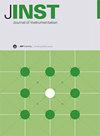Total solution processable and low-cost DNA methylation sensor
IF 1.3
4区 工程技术
Q3 INSTRUMENTS & INSTRUMENTATION
引用次数: 1
Abstract
DNA methylation sensor is an emerging demand of modern medical for laboratory, though lots of efforts have been contributed in this discipline, the easy-to-operate and efficient sensing terminal is still in deficiency. In this work, a total solution processable printing technology is proposed to fabricate the DNA methylation sensor, which is based on the liquid gate graphene field effect transistor (Lg-GFET). Meanwhile, the graphene ink (G-ink) was prepared by using the modified liquid-exfoliation method, to facilitate printing production. Then, five kinds of tested single strand DNA (ssDNA) which have 0 to 4 5-methylcytosine (5mC) sites were covalently anchored on the graphene channel. X-ray photoelectron spectroscopy (XPS) was conducted to demonstrate the analyte ssDNA was successfully fixed. Thirdly, the 5mC sites were identified by their antibody of 5mC (5mCab) and transduced as the changed current between the source and drain electrodes ( I ds). It is found the proposed sensor has good linear sensitivity (about -1.68% for per 5mC) to the amount of 5mC sites on the tested ssDNAs with Pearson correlation coefficient -0.98 and excellent anti-interference to unmethylated ssDNAs. Besides, the cost is estimated to be about $ 1.5 for each of the proposed DNA methylation sensor. Conclusively, the proposed low-cost component may be an efficient candidate for promoting the instant DNA methylation determination.全溶液可加工和低成本的DNA甲基化传感器
DNA甲基化传感器是现代医学对实验室的新兴需求,虽然在这一领域已经做出了大量的努力,但易于操作和高效的传感终端仍然缺乏。本文提出了一种基于液态栅极石墨烯场效应晶体管(Lg-GFET)的全溶液可加工印刷技术来制备DNA甲基化传感器。同时,采用改进的液体剥离法制备石墨烯油墨(G-ink),便于印刷生产。然后,五种具有0至4个5-甲基胞嘧啶(5mC)位点的被测单链DNA (ssDNA)被共价锚定在石墨烯通道上。x射线光电子能谱(XPS)证实分析物ssDNA被成功固定。第三,5mC位点通过5mC抗体(5mCab)进行鉴定,并作为源极和漏极之间的变化电流(I ds)进行转导。研究发现,该传感器对被测ssdna上5mC位点的数量具有良好的线性灵敏度(约为-1.68% / 5mC), Pearson相关系数为-0.98,对未甲基化的ssdna具有良好的抗干扰性。此外,每个DNA甲基化传感器的成本估计约为1.5美元。最后,提出的低成本组件可能是促进即时DNA甲基化测定的有效候选。
本文章由计算机程序翻译,如有差异,请以英文原文为准。
求助全文
约1分钟内获得全文
求助全文
来源期刊

Journal of Instrumentation
工程技术-仪器仪表
CiteScore
2.40
自引率
15.40%
发文量
827
审稿时长
7.5 months
期刊介绍:
Journal of Instrumentation (JINST) covers major areas related to concepts and instrumentation in detector physics, accelerator science and associated experimental methods and techniques, theory, modelling and simulations. The main subject areas include.
-Accelerators: concepts, modelling, simulations and sources-
Instrumentation and hardware for accelerators: particles, synchrotron radiation, neutrons-
Detector physics: concepts, processes, methods, modelling and simulations-
Detectors, apparatus and methods for particle, astroparticle, nuclear, atomic, and molecular physics-
Instrumentation and methods for plasma research-
Methods and apparatus for astronomy and astrophysics-
Detectors, methods and apparatus for biomedical applications, life sciences and material research-
Instrumentation and techniques for medical imaging, diagnostics and therapy-
Instrumentation and techniques for dosimetry, monitoring and radiation damage-
Detectors, instrumentation and methods for non-destructive tests (NDT)-
Detector readout concepts, electronics and data acquisition methods-
Algorithms, software and data reduction methods-
Materials and associated technologies, etc.-
Engineering and technical issues.
JINST also includes a section dedicated to technical reports and instrumentation theses.
 求助内容:
求助内容: 应助结果提醒方式:
应助结果提醒方式:


